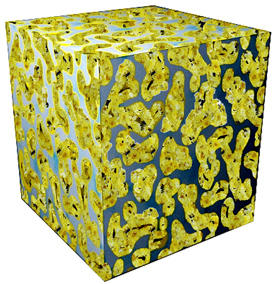

07/27/2015

© 2015 WILEY-VCH Verlag GmbH & Co. KGaA, Weinheim
A supercapacitor material that has a high charge storage capacity (capacitance) per unit mass and operates over a very wide voltage range has been developed by AIMR researchers1. The combination of these two properties makes it a promising material for high-energy-density supercapacitors that could complement or even replace conventional batteries.
Supercapacitors are attractive for powering devices ranging from portable electronic devices to hybrid electric vehicles as they can harvest and deliver charge much faster than batteries and so can be recharged in seconds rather than hours. They can also be recharged significantly more times than batteries. However, they tend to be very bulky — about ten times larger than batteries — to compensate for the fact that they store energy at relatively low densities. Consequently, supercapacitor materials capable of achieving high energy densities are highly sought after.
Now, a team led by Mingwei Chen at the AIMR, Tohoku University, has succeeded in producing just such a material. Importantly, it simultaneously has a very high capacitance per unit mass (specific capacitance) and operates over a very wide voltage range (large working potential window). While many new supercapacitor materials have been developed that have one of these two properties, very few exhibit both. But since the energy density increases with increasing specific capacitance and working potential window, maximizing both is essential for realizing high energy densities.
Previously, the team had found that two-component oxyhydroxides offer high specific capacitances but have narrow working potential windows because they are unstable at high potentials. To overcome this limitation, they produced a three-component system by doping a nickel hydroxide with copper and manganese. They discovered that this co-doping extended the working potential window considerably beyond an important bottleneck.
“The most important finding is that the working potential window of the oxyhydroxide exceeds the thermodynamic potential window of water electrolysis,” explains Chen. “Most other active electrode materials are limited by this potential.”
The researchers fabricated the material by creating nanopores in a nickel–manganese–copper alloy by leaching some of the manganese and then oxidizing the alloy by treating it in a solution of potassium hydroxide to produce a nanoporous metal oxyhydroxide (see image).
The material is already attracting the interest of industry. “We are currently working with a couple of companies to use this material in uninterruptible power supplies and other large-scale energy storage devices,” says Chen.
The researchers also have plans to further optimize the structure and composition of the material.
Kang, J., Hirata, A., Chen, L., Zhu, S., Fujita, T. & Chen, M. Extraordinary supercapacitor performance of a multicomponent and mixed-valence oxyhydroxide. Angewandte Chemie International Edition 54, 8100–8104 (2015). | article
This research highlight has been approved by the authors of the original article and all information and data contained within has been provided by said authors.